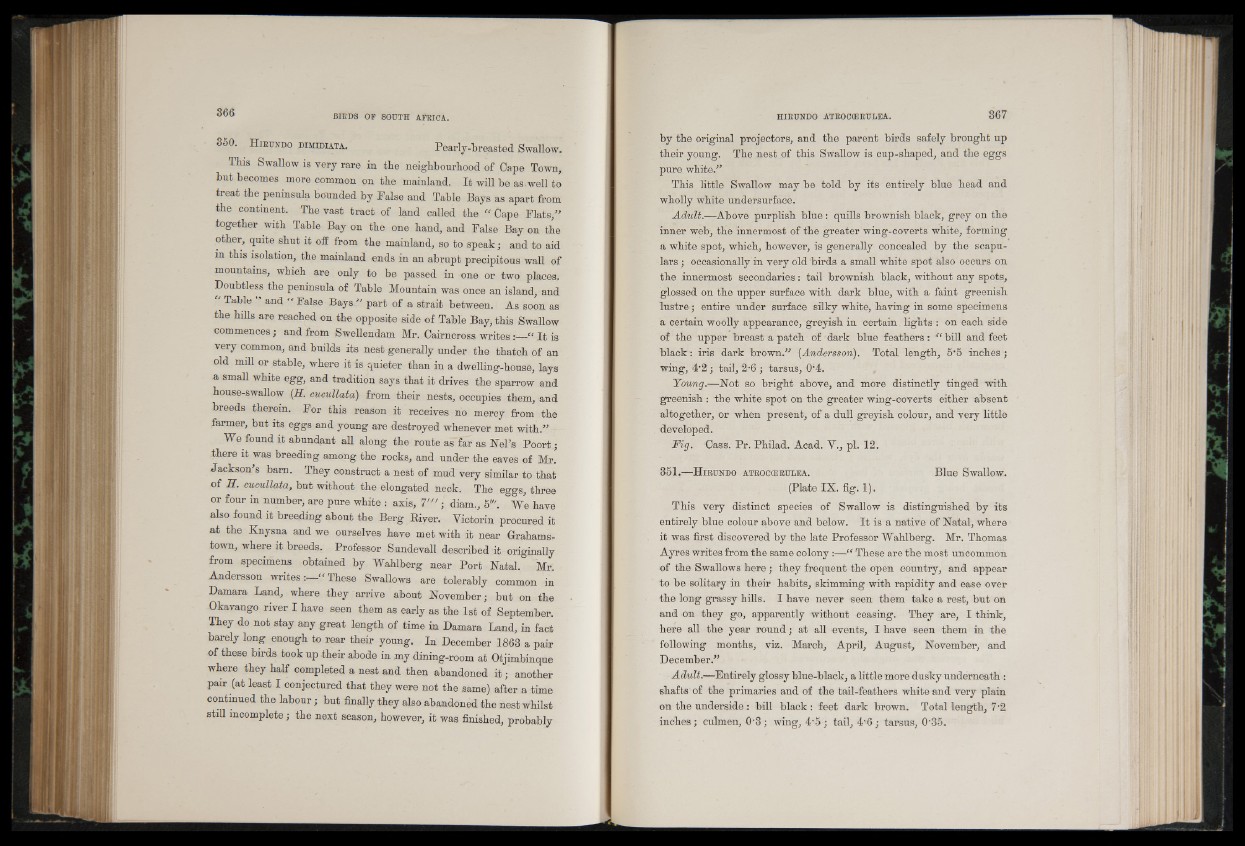
350. H irundo d imid ia ta . Pearly-breasted Swallow.
This Swallow is very rare in the neighbourhood of Cape Town,
but becomes more common on the mainland. It will be as.well to
treat the peninsula bounded by False and Table Bays as apart from
the continent. The vast tract of land called the “ Cape Flats/’
together with Table Bay on the one hand, and False Bay on the
other, quite shut it off from the mainland, so to speak; and to aid
in this isolation, the mainland ends in an abrupt precipitous wall of
mountains, which are only to be passed in one or two places.
Doubtless the peninsula of Table Mountain was once an island, and
‘ Table ” and “ False Bays ” part of a strait between. As soon as
the hills are reached on the opposite side of Table Bay, this Swallow
commences; and from Swellendam Mr. Cairncross writes :—“ I t is
very common, and builds its nest generally under the thatch of an
old mill or stable, where it is quieter than in a dwelling-house, lays
a small white egg, and tradition says that it drives the sparrow and
house-swallow (E. cucullata) from their nests, occupies them, and
breeds therein. For this reason it receives no mercy from the
farmer, but its eggs and young are destroyed whenever met with.”
We found it abundant all along the route as far as Nel’s Poort;
there it was breeding among the rocks, and under the eaves of Mr!
Jackson’s bam. They construct a nest of mud very similar to that
of E. cucullata, but without the elongated neck. The eggs, three
or four in number, are pure white : axis, 1’" ; diam., 5'". We have
also found it breeding about the Berg River. Yietorin procured it
at the Knysna and we ourselves have met with it near Grahams-
town, where it breeds. Professor Sundevall described it originally
from specimens obtained by Wahlberg near Port Natal. Mr.
Andersson wntes: “ These Swallows are tolerably common in
Damara Land, where they arrive about November; but on the
Okavango river I have seen them as early as the 1 st of September.
They do not stay any great length of time in Damara Land, in fact
barely long enough to rear their young. In December 1863 a pair
of these birds took up their abode in my dining-room at Otjimbinque
where they half completed a nest and then abandoned i t ; another
pan- (at least I conjectured that they were not the same) after a time
continued the labour; but finally they also abandoned the nest whilst
still incomplete; the next season, however, it was finished, probably
by the original projectors, and the parent birds safely brought up
their young. The nest of this Swallow is cup-shaped, and the eggs
pure white.”
This little Swallow may be told by its entirely blue head and
wholly white undersurface.
Adult.—Above purplish blue : quills brownish black, grey on the
inner web, the innermost of the greater wing-coverts white, forming
a white spot, which, however, is generally concealed by the scapulars
; occasionally in very old birds a small white spot also occurs on
the innermost secondaries: tail brownish black, without any spots,
glossed on the upper surface with dark blue, with a faint greenish
lustre; entire under surface silky white, having in some specimens
a certain woolly appearance, greyish in certain lights : on each side
of the upper breast a patch of dark blue feathers: “ bill and feet
black: iris dark brown.” (Andersson). Total length, 5'5 inches;
wing, 4'2 ; tail, 2-6 ; tarsus, 0'4.
Young.—Not so bright above, and more distinctly tinged with
greenish : the white spot on the greater wing-coverts either absent
altogether, or when present, of a dull greyish colour, and very little
developed.
JFig. Cass. Pr. Philad. Acad. V., pi. 12.
351.—H irundo atroccerulea. Blue Swallow.
(Plate IX. fig. 1).
This very distinct species of Swallow is distinguished by its
entirely blue colour above and below. It is a native of Natal, where
it was first discovered by the late Professor Wahlberg. Mr. Thomas
Ayres writes from the same colony :—“ These are the most uncommon
of the Swallows here; they frequent the open country, and appear
to be solitary in their habits, skimming with rapidity and ease over
the long grassy hills. I have never seen them take a rest, but on
and on they go, apparently without ceasing. They are, I think,
here all the year round; at all events, I have seen them in the
following months, viz. March, April, August, November, and
December.”
Adult.—Entirely glossy blue-black, a little more dusky underneath :
shafts of the primaries and of the tail-feathers white and very plain
on the underside : bill black: feet dark brown. Total length, 7'2
inches; culmen, 0-3; wing, 4 '5 ; tail, 4-6; tarsus, 0'35.